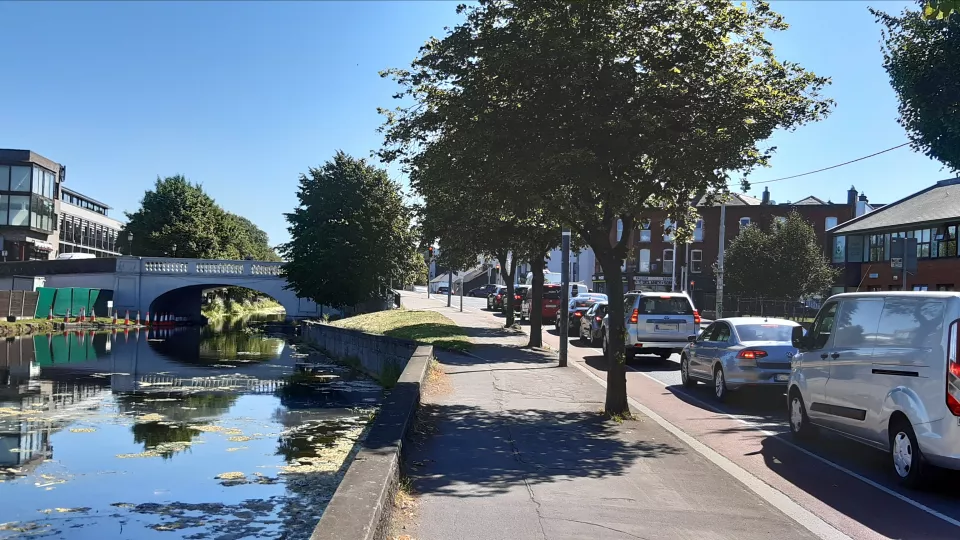Grand Canal Pedestrian and Cycle Safety Improvements
Dublin City Council plans to provide 3.8km of safer walking and cycling facilities along the Grand Canal. This scheme is currently at the Construction phase.
The Grand Canal Pedestrian and Cycle Safety Improvements Scheme is part of the Dublin City Council's plans for a 314km Active Travel Network. It is funded by the National Transport Authority and aims to improve walking and cycling facilities along a 3.8km route.
The route extends from Dolphin Road, at its junction with Slievenamon Road, to Grand Parade, at its junction with Leeson Street. Seven major and seven minor junctions will be upgraded to make them safer for vulnerable road users, pedestrians and cyclists. Eight new signalised pedestrian crossings will also be installed.
You can view our interactive map to see where this scheme fits into the citywide Active Travel Network.
Construction on this scheme first began in June 2022 with works carried out by SIAC Construction on behalf of Dublin City Council. Unfortunately, completion of the scheme was delayed due to the collapse and liquidation of SIAC Construction in 2023. Two new contractors, Actavo Ltd and SIAC Bituminous Products, were appointed after a public tender process and a reduced programme of works recommenced in 2024.
Scope and Purpose
Concept Development and Option Selection
Preliminary Design
Statutory Processes and Public Consultation
Detailed Design and Procurement
Construction
Close-Out and Review
Learn More About the Scheme
Key Changes
The Grand Canal Pedestrian and Cycle Safety Improvements Scheme will:
- Deliver improved pedestrian facilities by upgrading footpaths and installing nine additional pedestrian crossings along the route.
- Improve the quality infrastructure for cyclists, by resurfacing and increasing the widths of on-road cycle lanes.
- Extend footpaths at 11 junctions to provide shorter, safer and more convenient pedestrian crossing points for all ages and abilities.
- Deliver street improvements by reconstructing footpaths along the route.
- Provide safe pedestrian and cycle links from Drimnagh, Dolphin's Barn and Harold's Cross to the Grand Canal, making the Grand Canal accessible for all.
- Improve the comfort and safety of walking and cycling for both commuting and leisure purposes. It will benefit those going to local schools, such as St. Clares, St. Marys College, Scoil Iosagain and Scoil Mhuire Og, and local sports grounds, such as Templeogue Synge Street GAA and Good Counsel GAA club.
- Contribute to a reduction in transport emissions in line with the objectives of the Climate Action Plan by encouraging Active Travel and public transport use.
This scheme will provide safe and accessible pedestrian and cycle links from Drimnagh, Dolphin's Barn and Harold’s Cross to the Grand Canal, making the Grand Canal accessible for all. It will improve comfort and safety for walking and cycling for both commuting and leisure purposes. It will also contribute to a reduction in transport emissions by encouraging a shift to Active Travel and public transport use.
The scheme consists of safety and traffic calming measures only and, for that reason, planning approval was not required.
The National transport Authority is funding this scheme.
SIAC Construction Limited was appointed as the contractor before going into liquidation in 2023. Two new contractors, Actavo Ltd and SIAC Bituminous Products, were appointed to complete construction of the scheme in 2024.
The National Transport Authority’s Cycle Design Office are the designers of this scheme.
The traffic management arrangements during the works will maintain a minimum of two lanes of traffic through the project corridor, with one eastbound lane and one westbound lane provided.
Eastbound and westbound routes for cyclists and footpath users will be maintained through the area too and local access will be facilitated at all times.
Along some sections of the route short duration works may require a traffic lane reduction to one lane for short periods. These works will be programmed at times when they will cause the least possible disruption. Some evening works may also be required.


